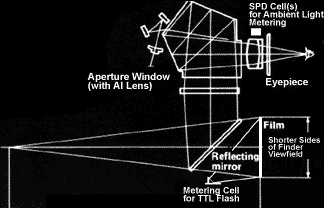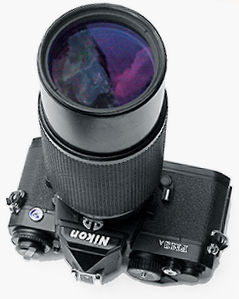The famed Nikon bayonet
lens mount, more popularly known as Nikon F-mount occupies the center section of
the FM3a camera. It serves a few purposes, it supports and locate the lens precisely
with 3 rugged, long lasting projecting bayonet lugs
* which mate with 3 similar
projections on the lens. It also permits communication between camera and lens via
levers and pins on both ends. Basically, these mechanical levers provide two main
automatic functions with most Nikkor lenses in both automatic diaphragm operation
and full aperture metering.
The Nikon standard 44mm diameter bayonet lens mounting flange provides an exacting 46.5mm flange to film distance and the bayonet design of the mount also enables a short 60° twist-to-lock action for quick and sure connection. The aperture inside each Nikkor lens is formed by a diaphragm with pivoted overlapping metal leaves which in turns moves uniformly to change the size of the lens opening. Small aperture means smaller lens opening and since there is less light coming through, the viewfinder will be dimmed. Nikon has designed a system in order to enable comfort viewing even if aperture is selected to smaller value on the lens. This automatic process is done by a mechanism inside the camera body which tripped another lever on the lens section by an aperture stopped down lever located at the left hand portion inside the lens mount. Most Nikkor lenses have this automatic feature to take advantage of this automatic full aperture metering, for those that can't, they must be either too old of a lens type or a special application for one reason or another.
How to ensure you got the right lens to use with the FM3a ? Simple, basically, it only needs a minimum specification of any lens that carries an AI-specification. | Click here to check | lens compatibility and distinguishing your lens types.
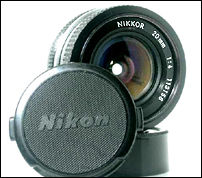 |
The FM3a has a fixed meter coupling lever on the lens mount similar to FM2(n) and therefore, non-Ai Nikkor lenses may not be able to couple with the metering mechanism. Although such non-comforming lenses can still be mount and use in stopped down mode, but Nikon has advised against such action in its manual. Claiming attempt to mount any non-Ai optic onto FM3a may damage the meter coupling tab, so I think you should follow their advice rather than mine, hehe .. |
With the lens removed, you can see the interior section of the lens mount. Inside you will see a large half-silvered reflex mirror. The size of the FM3a reflex mirror is quite large, which is large enough to ensure projecting even light distribution across its picture viewfield for use of super-telephoto lenses up to 880mm or when used with close-up accessories such as bellows attachment and/or extension tubes without apparent image cutoff. The reflex mirror's main function remains as to enable parallax-free image viewing/focusing/composing though the lens attached onto the camera body.
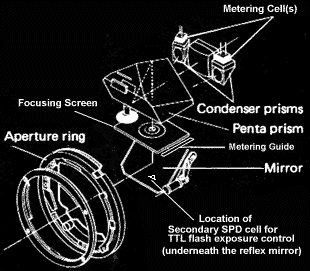 |
|
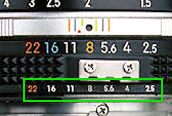 |
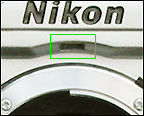 |
Just above the lens mount, hidden under the protruding angled pentaprism is a small tiny opening which is called the aperture window. Its main purpose is, when any Ai-spec Nikkor lens which has a secondary aperture direct readout scale is attached to the camera, the aperture value in use will be relay to the finder and display at the top menu (see illustration at the top). |
 |
Towards the right hand side of the camera, you will find the lens release button located just next to the lens mount; there are two other features, namely a conventional PC terminal and a new flash exposure compensation button which both relate directly to flash photography and these will be addressed at the related chapters that follow.
| Previous | NEXT | The new film back for FM3a, other alternative, Auto-exposure Lock, eyepice section and usable accessories
Page 1 | 2 | 3 | 4 | 5 | 6 | 7 | 8 | 9 | 10 | 11 | 12 |
| BACK | to Main Index Page
of Nikon FM3A
|
Other
Issues
relate to Nikon FM3A - Index
Page
|
| Instruction Manual for Nikon FM3A
|
| Technical Specification |
Main
Reference Map
|
Standard
production Nikon FM Series models:-
Nikon FM | Nikon FM2 | Nikon FM2n | Nikon FM10 | Nikon FM3a |
Known
variants:-
Nikon
FM Gold
| Nikon
FM2/T
| Nikon
FM2N Tropical Set
| Nikon
FM2/T Limited Edition
| Nikon
FM2N LAPITA
|
Nion
FM2n Millennium 2000
| Message Board | for
your favourite Nikon
FM Series SLR models
| Message
Board | for your Nikon
Optics in a shared environment
| Message Board | Specifically for Dispose or Looking for Nikon/Nikkor
Photographic Equipment
| Back | Main Index
Page of Nikon FM series Bodies
Shared Resources: MD-11 | MD-12 | Focusing Screens | Titanium Shutter | older dedicated Flash Units for FM series -SB-16 | SB-15 | SB-10 or other Options | Databack | Nikkor lens mount (related info)
Others:- Nikon AF-TTL Speedlights | SB-20 (1986) | SB-22 (1987) | SB-23 | SB-24 (1988) | SB-25 (1991/2) | SB-26 (1994) | SB-27(1997) | SB-28 (1997) | Nikon SB-29(s) (2000) | Nikon SB-30 (2003) | Nikon SB-600 (2004) | Nikon SB-800 (2003) Nikon AF-TTL Speedlight DX-Series: Nikon SB-28DX (1999) | SB-50DX (2001) | SB-80DX (2002) (updated)
Nikon
BC-flash Series |
Original
Nikon Speedlight
SB-2
| SB-3
| SB-4
| SB-5
| SB-6
| SB-7E
| SB-8E
| SB-9
| SB-E
| SB-10
SB-11
| SB-12 | SB-14 | SB-140 UV-IR| SB-15 | SB16A | SB-17 | SB-18, SB-19 | SB-21A (SB-29) Macro flash | Flash Accesories | SF-1
Pilot Lamp
Instruction
Manual: Nikon FM (HTML | PDF) | Nikon FM-10 (HTML) | Nikon FM2n's
User's Manual
available only in HTML format (6
parts) | Nikon FM3A (HTML)
Specifications: Nikon FM, FM-10, FM2, FM2n and FM3A
Main Reference Map: (HTML) Nikon FM, FM2, FM-10, FM2n (Applicable
to FM2T, FM2 "Year of the Dog"; Millennium 2000") and FM3A
| Nikon F | Nikon F2 | Nikon F3 | Nikon F4 | Nikon F5 | Nikon F6 | Nikkormat / Nikomat | Nikon FM | Nikon FE/ FA | Nikon EM/FG/FG20 | Nikon Digital SLRs | Nikon - Other models |
Nikon Auto Focus Nikkor lenses:- Main
Index Page
Nikon Manual Focus Nikkor lenses:- Fisheye-Nikkor Lenses - Circular | Full Frame |
Ultrawides Lenses - 13mm15mm18mm20mm | Wideangle Lenses - 24mm28mm35mm | Standard Lenses - 45mm 50mm 58mm | Telephoto
Lenses - 85mm105mm135mm180mm & 200mm | Super-Telephoto Lenses - 300mm 400mm 500mm 600mm 800mm 1200mm |
 Index Page |
Special
Application lenses: Micro-Nikkor Lenses - 50mm~55mm -60mm 85mm -105mm 200mm Micro-Zoom 70-180mm Perspective Control (PC) - 28mm 35mm PC-Micro 85mm Dedicated Lenses for Nikon F3AF: AF 80mm f/2.8 | AF 200mm f/3.5 EDIF Depth of Field Control (DC): 105mm 135mm Medical Nikkor: 120mm 200mm Reflex-Nikkor Lenses - 500mm 1000mm 2000mm Others: Noct Nikkor | OP-Nikkor | UV Nikkor 55mm 105mm | Focusing Units | Bellows-Nikkor 105mm 135mm Nikon Series E Lenses: 28mm35mm50mm100mm135mm | E-Series Zoom lenses: 36~72mm75~150mm70~210mm |
MF Zoom-Nikkor Lenses: 25~50mm | 28~45mm | 28~50mm | 28~85mm | 35~70mm | 36~72mm E | 35~85mm | 35~105mm | 35~135mm | 35~200mm | 43~86mm | 50~135mm | 50~300mm | 70~210mm E | 75~150mm E | 80~200mm | 85~250mm | 100~300mm | 180~600mm | 200~400mm | 200~600mm | 360~1200mm | 1200~1700mm
Tele-Converters: TC-1 | TC-2 | TC-200 | TC-201 | TC-300 | TC-301 | TC-14 | TC-14A | TC-14B | TC-14C | TC-14E | TC-16 | TC-16A | TC-20E
Recommended links to understand more technical details
related to the Nikkor F-mount and production Serial Number:
http://rick_oleson.tripod.com/index-153.html by: my
friend, Rick Oleson
http://www.zi.ku.dk/personal/lhhansen/photo/fmount.htm by: Hansen,
Lars Holst
http://www.mir.com.my/rb/photography/hardwares/nikonfmount/lens2.htm
http://www.photosynthesis.co.nz/nikon/serialno.html
W A R N I N G: The New G-SERIES Nikkor lenses have no aperture ring on the lens, they CANNOT ADJUST APERTURES with any of these manual focus Nikon FE series SLR camera models; please ignore some portion of the content contained herein this site where it relates.
|
Back | Main Index Page of Nikkor Resources
|
Back | Main Index Page of Pictorial
History of Nikon SLRs
| Message Board | for your Nikkor optics ("shared" because I do wish some of you to expose to other's perspective as well. Isn't it a sad sate to see photography has to be segmented into different camps from the use of various labels)
about this photographic web site
Home - Photography in Malaysia |
Credit: To all the good people who has contributed their own experience, resources or those who are kind enough granting us permission to use their images appeared in this site. Mr. MCLau®, who has helped to rewrite some of the content appeared this site. Chuck Hester® who has been helping me all along with the development of all these Nikon websites;LarsHolst Hansen, 'Hawkeye' who shares the same passion I have; Ms Rissa, Sales manager from Nikon Corporation Malaysia for granting permission to use some of the official content; TedWengelaar,Holland who has helped to provide many useful input relating to older Nikkor lenses; Some of the references on production serial numbers used in this site were extracted from Roland Vink's website; HiuraShinsaku from Nikomat Club Japan. t is also a site to remember a long lost friend on the Net. Note:certain content and images appeared in this site were either scanned from official marketing leaflets, brochures, sales manuals or publications published by Nikon over the years and/or contribution from surfers who claimed originality of their work for educational purposes. The creator of the site will not be responsible for may discrepancies arise from such dispute except rectifying them after verification."Nikon", "Nikkormat", "Nippon Kokagu KK" & "Nikkor" are registered tradename of Nikon Corporation Inc., Japan. Site made with an Apple IMac.

